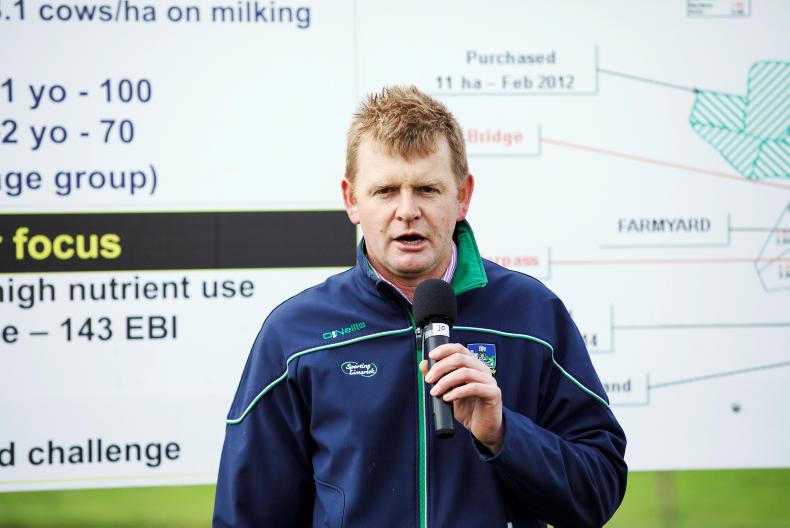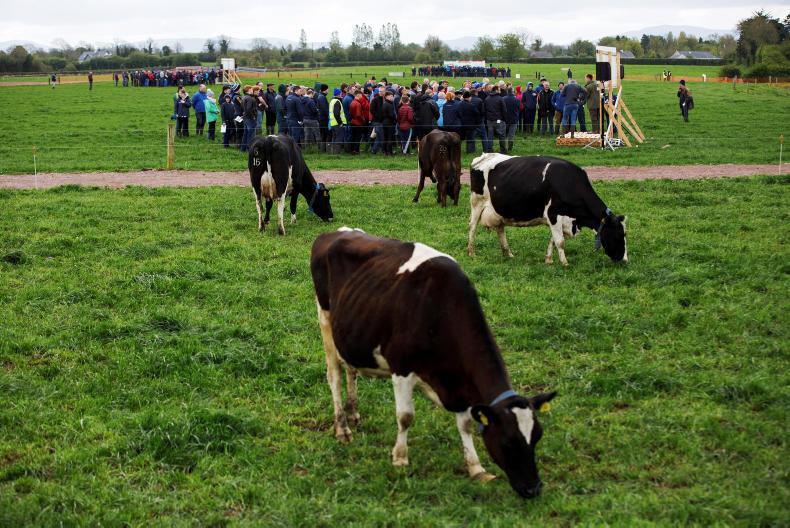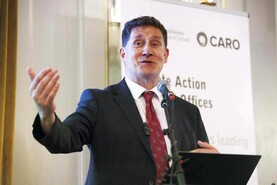Big crowds turned up in Limerick on Wednesday for the Grassland Farmer of the Year national open day.
The hosts were the Macnamara family from Knockainey, who won the competition in 2018. John and Olivia are milking 244 cows on a 78ha milking platform. When John took over the farm in 1992 they were milking fewer than 50 cows.
Growth over the last 27 years has been gradual. Most of the increase in cow numbers has come about because John is getting more out of the land he has.
Average grass growth over the last five years was 15tDM/ha and this supports a stocking rate of 3.1 cows/ha on the milking block. The overall size of the farm has increased too though, with 11ha purchased in 2012 and 12ha purchased in 2014.
Olivia’s home farm is also used as a support block for rearing heifers and producing silage. There is also 20ha of land leased next to the milking block.

Host farmer John Macnamara speaking at the Grassland Farmer of the Year open Day on his farm in Knockainey, Co Limerick \ Donal O' Leary
Scale is one thing, but what you do with land is another. This farm walk was not about farm expansion; it was very much about being efficient and sustainable with the assets we have.
That awful word, sustainability came up numerous times. Sean McCarthy from Kerry Agribusiness said there are three Ps in sustainability – people, planet and profit.
In terms of people, the Macnamara farm is very much a family farm, with all members of the family helping out when needed. John has been involved in training young people for many years.
Students from Pallaskenry Agricultural College regularly attend the farm and John has also been a host farmer for the professional farm manager course since the course started.
Gavin O’Donoghue is the current farm manager student. Last year’s student Gearoid Slattery was speaking about how they manage grass on the farm.
“People sustainability involves both the farmer and anyone else working on the farm such as employees, contractors and service technicians.
"There’s a scarcity of good people in lots of industries and farming is no different. As farmers we need to be conscious of finishing times, paying people on time, getting regular time off and knowing that part of the job of being a farmer is to train the next generation of farmers,” Sean said.
The second P, planet, received a lot of attention. Sean said that internationally, Irish farmers are well positioned in terms of greenhouse gas emissions and water quality, but that we still need to improve: “While we are one of the lowest emitters of greenhouse gases per kilo of milk solids produced in the world, our dairy herd is increasing in size so total emissions are going up. We can’t sit back and think everything is OK.
"Focusing on things like lengthening the grazing season and using less inputs will be good for the environment and will also make the farmer more money.”

Despite having some heavy type soils and farming alongside a river, John still manages to have a long grazing season of between 280 and 290 days.
Soil fertility is good – the farm is on target for pH and is at index three for phosphorus and potassium, meaning nutrients such as nitrogen are available to be taken up by plants and the soil is healthy.
Nitrogen use efficiency on the Macnamara farm is 29%, while the average for the country is 25%.
This means that 29% of all the nitrogen brought on to the Macnamara farm is exported off in the form as product, mainly milk.
John’s carbon footprint is 0.99kg CO2eq/kg milk while the industry average is 1.05kg CO2eq/kg milk.
Using products such as protected urea and low-emission slurry spreading will reduce greenhouse gases and ammonia losses
Sean said John can still improve both the nitrogen use efficiency and also his carbon footprint by being more targeted with nitrogen application, feeding less supplement and lower-protein supplements.
Carbon footprint per unit of product will decrease as the herd continues to mature and output per cow increases. Using products such as protected urea and low-emission slurry spreading will reduce greenhouse gases and ammonia losses.
The final P in Sean’s matrix was to do with profit. He said profit is key to sustainability.

Sean McCarthy, Kerry Agri Business speaking during the Grassland Farmer of the Year open Day on the farm of John and Olivia Macnamara.\ Donal O' Leary
“John is delivering a milk price 4c/l to 5c/l higher than the base price through breeding good genetics and feeding the cows the best-quality grass available.
"John has focused on improving soil fertility and getting the infrastructure in place to enable him to utilise grass and this is what is delivering the extra profit. He has also taken the opportunity to grow the business.
“At the end of the day, the people who buy our dairy products want to see cows out grazing lush green grass.
"This grass-based system of milk production that we are promoting here today is good for the environment, good for profitability and good for society – it’s what people want to see. We have a very good story to tell – we just need to keep continuously improving and refining it,” Sean said.
The Macnamara herd is a mix of New Zealand Friesian-type Holstein Frieisans and Jersey crossbreds. About 70% of the straws used now are high-EBI Holstein Friesian, with the remainder Jersey. Fertility is good, with 86% of the herd calving in six weeks this year. Output in 2018 was good, with the herd producing 483kg of milk solids per cow from a total of 1.2t/cow of meal fed in 2018.
Average grass growth over the past five years has averaged 15tDM/ha and 11tDM/ha of this has been utilised by the herd
The amount of meal fed last year was much higher than normal due to the bad spring and drought. John normally feeds 400kg of meal per cow.
Average grass growth over the past five years has averaged 15tDM/ha and 11tDM/ha of this has been utilised by the herd. John completed 42 grass walks in 2018 and so far this year he has grown 1.4tDM/ha, which is a 33% increase on the three-year average. Average farm cover peaked at 1,177kg/ha in mid-February and was at 712kg/ha by the start of the second rotation in early April. John doesn’t want to be below 700kg/ha at the start of the second round as April can often be a poor growing month on his farm.
The plan for the next few weeks is to walk the farm every week and aim to go into covers of 1,400kg/ha with the cows. John will stock the milking platform at four cows/ha and any surplus paddocks will be removed as bale silage. The plan is to keep the cover per cow to between 160kg and 180kg/cow.

Young Dan Macnamara gets a vantage point during the Grassland Farmer of the Year Open Day on his uncle's farm. \ Donal O' Leary
According to the 2018 profit monitor, the dairy output from the farm equated to 39.6c/l while the common costs were 17.5c/l, giving a common profit of 22.1c/l. Of course, this doesn’t include the costs of own labour, rent debt repayments and taxation. Housing, milking facilities and grazing infrastructure are excellent.
The Macnamaras are excellent ambassadors for good, profitable grass based family dairy farming. The Irish Farmers Journal, along with Teagasc, Department of Agriculture, FBD, AIB and Grassland Agro are the sponsors of the Grassland Farmer of the Year competition.
Big crowds turned up in Limerick on Wednesday for the Grassland Farmer of the Year national open day.
The hosts were the Macnamara family from Knockainey, who won the competition in 2018. John and Olivia are milking 244 cows on a 78ha milking platform. When John took over the farm in 1992 they were milking fewer than 50 cows.
Growth over the last 27 years has been gradual. Most of the increase in cow numbers has come about because John is getting more out of the land he has.
Average grass growth over the last five years was 15tDM/ha and this supports a stocking rate of 3.1 cows/ha on the milking block. The overall size of the farm has increased too though, with 11ha purchased in 2012 and 12ha purchased in 2014.
Olivia’s home farm is also used as a support block for rearing heifers and producing silage. There is also 20ha of land leased next to the milking block.

Host farmer John Macnamara speaking at the Grassland Farmer of the Year open Day on his farm in Knockainey, Co Limerick \ Donal O' Leary
Scale is one thing, but what you do with land is another. This farm walk was not about farm expansion; it was very much about being efficient and sustainable with the assets we have.
That awful word, sustainability came up numerous times. Sean McCarthy from Kerry Agribusiness said there are three Ps in sustainability – people, planet and profit.
In terms of people, the Macnamara farm is very much a family farm, with all members of the family helping out when needed. John has been involved in training young people for many years.
Students from Pallaskenry Agricultural College regularly attend the farm and John has also been a host farmer for the professional farm manager course since the course started.
Gavin O’Donoghue is the current farm manager student. Last year’s student Gearoid Slattery was speaking about how they manage grass on the farm.
“People sustainability involves both the farmer and anyone else working on the farm such as employees, contractors and service technicians.
"There’s a scarcity of good people in lots of industries and farming is no different. As farmers we need to be conscious of finishing times, paying people on time, getting regular time off and knowing that part of the job of being a farmer is to train the next generation of farmers,” Sean said.
The second P, planet, received a lot of attention. Sean said that internationally, Irish farmers are well positioned in terms of greenhouse gas emissions and water quality, but that we still need to improve: “While we are one of the lowest emitters of greenhouse gases per kilo of milk solids produced in the world, our dairy herd is increasing in size so total emissions are going up. We can’t sit back and think everything is OK.
"Focusing on things like lengthening the grazing season and using less inputs will be good for the environment and will also make the farmer more money.”

Despite having some heavy type soils and farming alongside a river, John still manages to have a long grazing season of between 280 and 290 days.
Soil fertility is good – the farm is on target for pH and is at index three for phosphorus and potassium, meaning nutrients such as nitrogen are available to be taken up by plants and the soil is healthy.
Nitrogen use efficiency on the Macnamara farm is 29%, while the average for the country is 25%.
This means that 29% of all the nitrogen brought on to the Macnamara farm is exported off in the form as product, mainly milk.
John’s carbon footprint is 0.99kg CO2eq/kg milk while the industry average is 1.05kg CO2eq/kg milk.
Using products such as protected urea and low-emission slurry spreading will reduce greenhouse gases and ammonia losses
Sean said John can still improve both the nitrogen use efficiency and also his carbon footprint by being more targeted with nitrogen application, feeding less supplement and lower-protein supplements.
Carbon footprint per unit of product will decrease as the herd continues to mature and output per cow increases. Using products such as protected urea and low-emission slurry spreading will reduce greenhouse gases and ammonia losses.
The final P in Sean’s matrix was to do with profit. He said profit is key to sustainability.

Sean McCarthy, Kerry Agri Business speaking during the Grassland Farmer of the Year open Day on the farm of John and Olivia Macnamara.\ Donal O' Leary
“John is delivering a milk price 4c/l to 5c/l higher than the base price through breeding good genetics and feeding the cows the best-quality grass available.
"John has focused on improving soil fertility and getting the infrastructure in place to enable him to utilise grass and this is what is delivering the extra profit. He has also taken the opportunity to grow the business.
“At the end of the day, the people who buy our dairy products want to see cows out grazing lush green grass.
"This grass-based system of milk production that we are promoting here today is good for the environment, good for profitability and good for society – it’s what people want to see. We have a very good story to tell – we just need to keep continuously improving and refining it,” Sean said.
The Macnamara herd is a mix of New Zealand Friesian-type Holstein Frieisans and Jersey crossbreds. About 70% of the straws used now are high-EBI Holstein Friesian, with the remainder Jersey. Fertility is good, with 86% of the herd calving in six weeks this year. Output in 2018 was good, with the herd producing 483kg of milk solids per cow from a total of 1.2t/cow of meal fed in 2018.
Average grass growth over the past five years has averaged 15tDM/ha and 11tDM/ha of this has been utilised by the herd
The amount of meal fed last year was much higher than normal due to the bad spring and drought. John normally feeds 400kg of meal per cow.
Average grass growth over the past five years has averaged 15tDM/ha and 11tDM/ha of this has been utilised by the herd. John completed 42 grass walks in 2018 and so far this year he has grown 1.4tDM/ha, which is a 33% increase on the three-year average. Average farm cover peaked at 1,177kg/ha in mid-February and was at 712kg/ha by the start of the second rotation in early April. John doesn’t want to be below 700kg/ha at the start of the second round as April can often be a poor growing month on his farm.
The plan for the next few weeks is to walk the farm every week and aim to go into covers of 1,400kg/ha with the cows. John will stock the milking platform at four cows/ha and any surplus paddocks will be removed as bale silage. The plan is to keep the cover per cow to between 160kg and 180kg/cow.

Young Dan Macnamara gets a vantage point during the Grassland Farmer of the Year Open Day on his uncle's farm. \ Donal O' Leary
According to the 2018 profit monitor, the dairy output from the farm equated to 39.6c/l while the common costs were 17.5c/l, giving a common profit of 22.1c/l. Of course, this doesn’t include the costs of own labour, rent debt repayments and taxation. Housing, milking facilities and grazing infrastructure are excellent.
The Macnamaras are excellent ambassadors for good, profitable grass based family dairy farming. The Irish Farmers Journal, along with Teagasc, Department of Agriculture, FBD, AIB and Grassland Agro are the sponsors of the Grassland Farmer of the Year competition.










 This is a subscriber-only article
This is a subscriber-only article









SHARING OPTIONS: